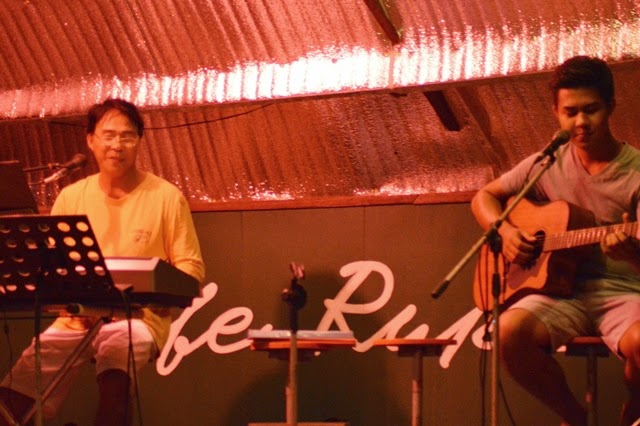Women: The silent victims of the effects brought by disasters
Pamela Pascual, 27 years old, washed their dishes using the rainwater earned from their improvised rain catcher.
Tacloban City, Leyte – “I cried every time I see my children begging for food and you have nothing to give,” said Pamela Pascual, 27 years old and a mother of two who were living in the bunkhouses for almost two years after the strongest typhoon wiped out their homes in San Jose in this City.
Pascual’s family was one of the lucky families who had been a recipient of a room in the bunkhouses constructed by the government. Yet, she was also one of the mothers who remained to suffer silently as she struggled putting their lives back into normalcy almost 2 years after the deadly storm.
They lived in the coastal area where her husband worked as a painter in a “pakyaw “ basis. Pascual proudly says that when they were still living in San Jose, her family eats three times a day but now they could hardly eat three times a day in a week.
“Kung dati nakakain kami ng tatlong beses sa isang araw sa buong lingo, ngayon hindi na. Minsan nalang sa isang lingo kami nakakakain. Wala na kasing permanenteng trabaho yung asawa ko, nawala na yung mga dating bossing nya, yung iba namatay ng Yolanda yung iba naman nasa Manila na,” Pascual said.
Like any other bunkhouse dwellers, Pascual is excited for their transfer to their permanent shelters, but they still don’t know when the schedule is for their transfer. She’s tired of every rule that have been imposed in the bunkhouses. According to her, being in that place for a long time didn’t seem to help them in starting their lives again.
“Minsan nga naiinggit na kami sa ibang mga tao kasi buti pa sila nakapag move on na kami hanggang nagyon andito pa. Hindi kami makapagsimula ng maayos. Naisip ko nga dati mas maayos pa yung buhay namin doon kaysa dito,” she added.
She admitted that typhoon Yolanda changed their lives and brought them to the most difficult situation. Her children became sickly because of the environment where they are living now.
The place is crowded and the comfort rooms were not functioning and nobody from the City government addressed this sanitary problem that leads to the health problems faced by the mothers and children in the bunkhouses.
Based on the ADB’s report entitled Fiscal Policies, inequality of climate change: How they make or break the rich-poor divide it says that “by and large, the poor are especially vulnerable, as they mostly live in low-lying coastal areas exposed to rising sea levels and storm surges, and slums or squatter settlements in urban areas highly susceptible to increasing severity and frequency of flooding due to poorly constructed homes in unplanned areas. Poor communities also have limited access to basic and emergency services, making the impacts of extreme weather events disproportionate for them. These events not only disrupt their livelihoods—through loss of assets—but also reduce their already limited access to basic social services, undermining their capacity to adapt to environmental shocks.”
“The impacts of calamities and disasters are more intense if combined with pre-existing inequalities, making the poor especially vulnerable. When Typhoon Haiyan ravaged and literally wiped off parts of Eastern Visayas in the Philippines in 2013, it did not respect places, big or small, nor discriminate against people, poor or non-poor. Hence, a transformative policy mix is needed to reduce the vulnerabilities for both.”
This first week of July, more than 3,000 families living along the coastal areas in Tacloban City are facing forced eviction. The families are intended to be transferred to the temporary shelters in the new township in the Northern part of the City.
But this pronouncement by the Mayor has been resisted by the immediate danger zone dwellers.
“Onsite development ang dapat gawin ng gobyerno. Ang pagtira naming sa Norte ay isang mabigat na bahage sa aming buhay. Andito ang aming hanapbuhay. Nag-aaral ang aming mga anak, walang eskwelahan doon. Karamihan sa amin ditto labor force at mangingisda. Alam natin lahat na hindi aabot sa minimum wage ang sahod namin dito, kaya mahirap. Alam mo ang tao kahit patalim hahawakan basta mabuhay lang. Ang gutom ang tunay na disaster ng buhay,” Pampango Homeowners Association President Leodegario Templado said.
Of the 1,541 target units for the transitional shelters, 1,004 were already built while 254 were still on-going and 695 of these were already occupied by storm surge survivors who came mostly from San Jose District in this City.
However, for the permanent shelters, out of the 11, 221 target housing of the National Housing Authority only 17 units have just been completed and occupied in Brgy Cabalawan based on the record of the City housing office in this City.
While those permanent shelters built by NGOs, out of 1,124 target units 375 of it have already been completed, 17 units were still on-going, 267 of it have been occupied and 61 units were still vacant. ###





Comments
Post a Comment